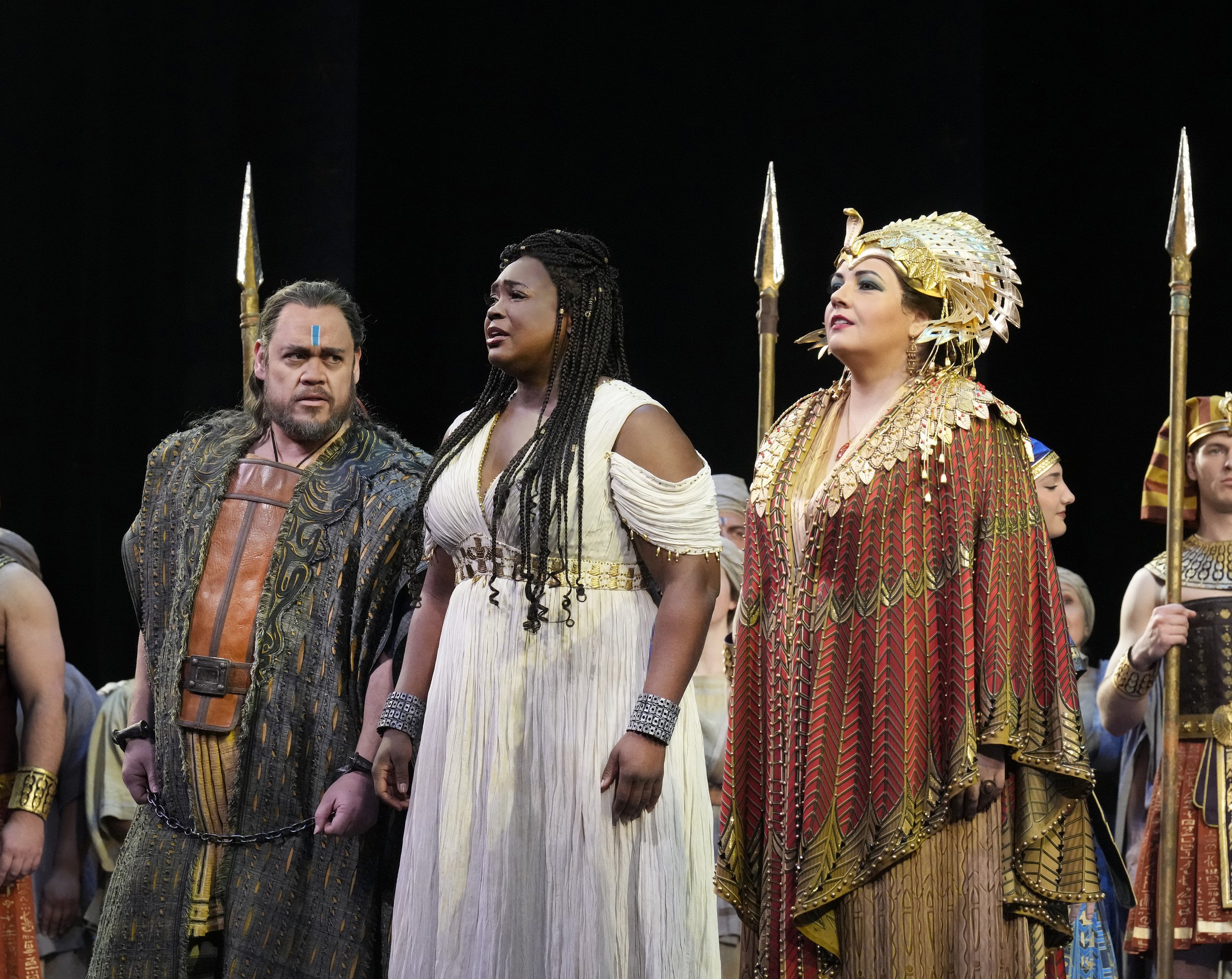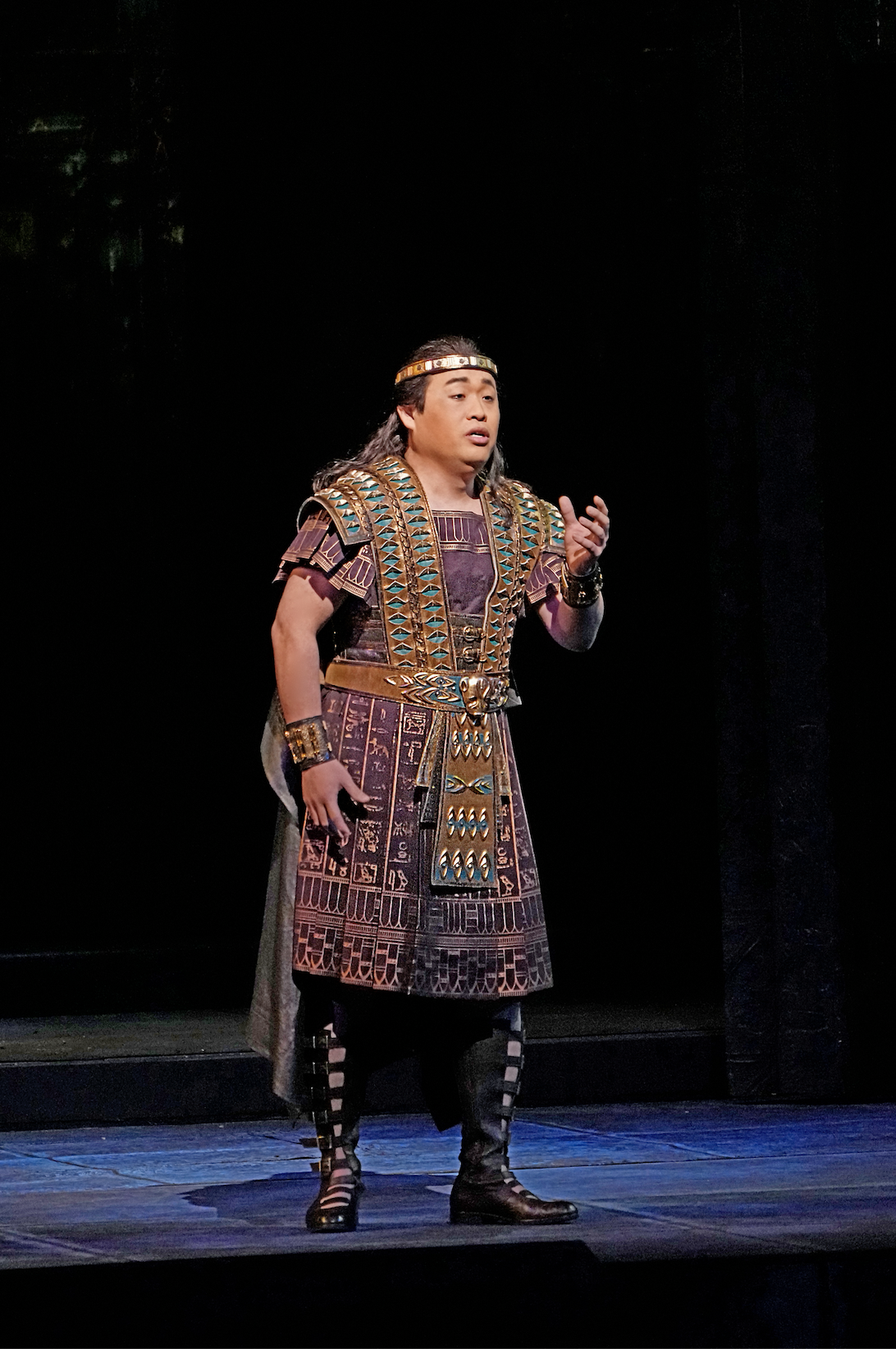Met Opera 2024-25 Review: Aida
Quinn Kelsey, Angel Blue, and Judit Kutasi in Aida (Ken Howard/Met Opera)
This review is of the performance on January 7, 2025.
New stagings always carry the weight of expectations, but Michael Mayer’s new Aida has the added burden of replacing one of the Met’s most beloved productions: Sonja Frisell’s stately mastodon of ancient Egyptian grandeur, retired two years ago after 34 years. Mayer’s staging has had a fairly bumpy road; it was originally scheduled to premiere on opening night of the 2020-21 season, but was tragically axed due to corona (I’m still not over that). Now, it’s finally here, and quite remarkable. Hang on to your amulets!
Angel Blue in Aida (Ken Howard/Met Opera)
Angel Joy Blue proved herself the finest Aida in years. She imbued the captive Ethiopian princess with a quiet dignity and nobility evident in her carriage and interactions with her costars, even when the production called for her to bow four times within a single minute. Her lyrical sound is more dramatic than when I heard her in Ainadamar, but she still has the vocal quality of a Honeycrisp apple: rosy and juicily sweet. (For the record, I love Honeycrisps.)
SeokJong Baek in Aida (Ken Howard/Met Opera)
South Korean tenor SeokJong Baek, filling in for an ailing Piotr Beczała, sang with heroic, generous sound and thrilled the audience by steadily holding the final high note of “Celeste Aida” for a considerable period of time. In Tosca earlier this season, he held “Vittoria!” for longer than I’ve heard anyone else do it. He’s grown artistically since his Met debut last season in Nabucco, and as the Egyptian general Radamès, he displayed a proud, confident bearing in his scenes with the priests and Amneris, despite having at most one rehearsal, although he lacked chemistry with Angel. He’s already a Met audience favorite, as evidenced by Girl of the Golden Met readers voting him their winner of the 2024 Best Tenor Award.
About Radamès, there’s something I don’t understand. After Amonasro tells him (completely unnecessarily, ruining everything) that he has revealed the military’s plans to the king of the Ethiopians, Radamès cries out “Io son disonorato!” I am dishonored! In the next act, he tells Amneris “I do not feel myself guilty… my thoughts are pure and my honor remains.” Then, just a few measures later, he says “I betrayed my honor and my country… Infamy awaits me.” Make up your mind, General! Are you disonorato or aren’t you?
Quinn Kelsey and Angel Blue in Aida (Ken Howard/Met Opera)
The evening’s most outstanding singing came from the Mighty Quinn Kelsey, at his now-typical excellence as Amonasro, king of the Ethiopians and Aida’s father. Every inch a king, his Amonasro either never took the time or never had the time to learn fatherhood, showing Angel’s Aida clumsy affection in between emotional manipulation. He was vocally impeccable, whether thundering with hair-raising rage or tenderly reminding Angel of Ethiopia’s natural beauty. I’m excited to report that this is my first Met season seeing Quinn in all his roles, as I also made it to his Rigoletto and Scarpia in the fall. He hoists his castmates a little bit closer to his level in every performance.
Judit Kutasi in Aida (Ken Howard/Met Opera)
Opening this production is a major assignment for Romanian mezzo-soprano Judit Kutasi, who only made her Met debut last season. Her dramatic commitment to the role of the Egyptian princess Amneris was unquestionable, although the confrontational way she whirled on people in the Judgement Scene verged on the comical, reminiscent of melodramatic cape-twirling. Puerto Rican soprano Amanda Batista brought a gleaming, ethereal sound to the “before she was famous” offstage role of the Priestess. She’s already going places; just last week, she received the 2025 Hildegard Behrens Foundation Award for outstanding young artists.
Now, let’s get to the elephant in the room: Mayer’s ambitious staging, the merits of which are the subject of hot debate. Frisell’s beloved Aida is hard to live up to and, in my view, Mayer’s decidedly does not. At times, he seems to draw heavily from Frisell, as when Aida goes to squeeze every Ethiopian prisoner’s hand (which is touching nevertheless), and in other places, Mayer’s Aida introduces new elements that feel like they’re just there to be new rather than serving an artistic purpose. Every time the gods are invoked, the priests half-raise their arms, palms upward. It’s a good concept, but it’s used far too often and gets annoying quickly, and there’s too much margin for error in its execution. Most of the priests look like they’re doing that distinctive “I’m innocent! Don’t shoot!” gesture. The priests-in-training, boys of about eight, nail it for the most part. The littles are an adorable addition, and I’m sure they enjoyed giving Radamès the sacred battle scimitar, a number where the adult priests hoist a kid above their heads every time he hands another the scimitar. (It better have very blunt edges.) This scimitar scene is cute but maddening: a good three minutes of the kids passing around the blade while Radamès stands there, itching to grab the thing. In the end, it isn’t even a kid who gives it to him but the priest Ramfis; yet another example of choosing novelty over dramatic value.
Judit Kutasi with handmaidens in Aida (Ken Howard/Met Opera)
Then there’s this controversial framing device: archaeologists discovering the ancient temple and thence the story. This did create two nice moments: first, during the overture — in which a digger in Indiana Jones garb rappels down into the temple, finds an artifact, and blows the dust off it, causing the hidden jewel tones of the wall carvings to be revealed via projections. Then, during the pause before Act 2 — a female archaeologist (Helena Shaw from The Dial of Destiny?) draws Amneris’s chamber on a sketchpad, while the lines she pencils in are projected onto the set, until we have a complete scene, the curtain rising to show us the princess’s room. Otherwise, the archaeologists kept popping up during the opera for no apparent reason other than to remind us that we are watching… a figment of their imagination? Their Western imperialist imagination? Is Aida’s story being discovered, remembered, or imagined? Later, the Triumphal March becomes the Raiders March; instead of Egyptian soldiers parading conquered booty, the archaeologists carry out of the temple various ancient (yet pristine) statues while Helena Shaw excitedly stops them so she can capture the images — with two pencil strokes, it seems. Sometimes the Tomb Raiders stop in the middle of the stage and make a 360° turn to fill time. As the final curtain draws near, Indy and Helena look on as Amneris prepares to commit hara-kiri (I can buy that.) and Radamès and Aida die in each other’s arms.
The Dance of the Shirtless Men in Aida (Ken Howard/Met Opera)
Still, the production’s visuals are colorful, intricate, and very beautiful. Susan Hilferty’s costumes are wonderful; Aida gets the prettiest of the royal handmaidens’ soft white dresses and Amneris, whose dominant color is red, wears a feather-patterned robe and gold headdress in Act 2 (although other of her robes resemble kimonos in certain poses). Oleg Glushkov makes a memorable Met debut as choreographer; the Dance of the Moorish Slaves is now the Dance of the Handmaidens (and, briefly, Amneris) but, though graceful and fluid, it’s not much of a stunner. That distinction goes to the triumphal celebration’s Dance of the Shirtless Men, which garnered the biggest applause of the evening for the gifted dancers’ displays of agility and athleticism.
Frankly, I prefer a gorgeous traditional production to one that updates for the sake of updating, as too many do nowadays. Next, I predict there’ll be an Aida set during the Nasser or Sadat regimes. (No, really, don’t go near that. The Middle East is enough of a mess without dragging it into opera.) Most of this cast’s principal singers made up for the unoriginal production, but it cannot carry the show on a less-than-stellar singing day like Frisell’s could. Luckily, the eminent Elīna Garanča takes over Amneris for four performances in the spring, and her presence alone merits a second trip to Indiana Jones’ Egypt.







